Banshee
| ACA Banshee | |
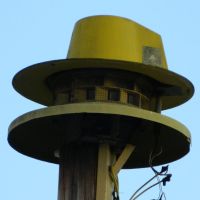 An inactive 9/12-port ACA Banshee 115, located in Monaca, PA. Photo by TrainsAndSirens1. | |
| Company | |
|---|---|
| Produced | 1968-2004 |
| Type | Omnidirectional Electromechanical |
| Sound output | 112-120 dB @ 100 ft |
| Frequency | 60 Hz |
| Horsepower | 10-20 hp |
| Voltage | 208-230/460 V AC 1 or 3 ph |
| Succeeded by | ASC Tempest |
The Banshee is a series of midrange omnidirectional mechanical sirens that was produced by Alerting Communicators of America, and later the American Signal Corporation, over nearly 40 years. Released onto the market in 1968 alongside the smaller Screamer series and the powerful Cyclone, the Banshee was a popular option for an omnidirectional siren, competing with Federal Signal's STH-10 and SD-10, as well as Sentry Siren's smaller omnidirectional offerings.
History
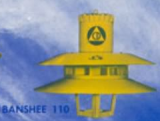
The Banshee was originally released by ACA in 1968, a year after BNCO's siren division was sold off, bought, and reformed into ACA. It succeeded a little-known omnidirectional version of the BNCO Mobil Directo known as the Model 110 which ceased production in 1967. There were two models available, the smaller single-rotor Banshee 110, and the much larger dual-rotor SuperBanshee 115. The single-rotor Banshee 115 would be introduced sometime in 1973, replacing the Banshee 110 in ACA's lineup. It was intended as a midrange option, being more powerful than the Screamer series while not being as powerful as the Cyclone.
ACA would release the "Performance Plus" Banshee in 1989, intended to be part of their aforementioned Performance Plus series. The Banshee 115 and SuperBanshee would be sold until 1994, when ACA went bankrupt and reformed into ASC, with the Performance Plus Banshee being renamed to the OM-120. The Banshee 115's name would also be changed to the OM-117. The OM-117 and OM-120 would be produced from then up until 2004 when they were discontinued and replaced with the Tempest series of sirens.
Design
The Banshee is a simple siren in design. The Banshee uses a directional rotor and stator, meaning that it must spin in the right direction or sound output will be reduced significantly. The siren's motor is located on top of the siren, being completely exposed on the Banshee 110, and protected on the Banshee 115. The intake is located on the bottom, where the siren is mounted. Like all of ACA's other sirens, the Banshee uses a fiberglass shroud to cover the motor, as well as two skirts to project the sound outwards. This helps prevent corrosion. The four models of Banshee are as follows:
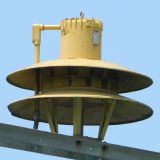
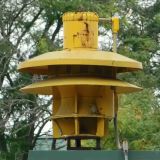
Banshee 110 (1968-1973)
The Banshee 110 was the first model of Banshee released, being released alongside the SuperBanshee in 1968. The Banshee 110 is very simple, lacking a cover for the motor on top, using a much different intake design, and often lacking the lips on the skirts and it looks like a Screamer. The Banshee 110 was originally only available in 10/12 dual tone, using the rotor and stator from the first generation 10/12 ACA Allertor 125, and is also the rotor/stator used on the dual tone versions of the BNCO Mobil Directo. In 1970, the 10/12 option was dropped in favor of the 9/12 dual tone, and 8-port single tone and 8/12-port dual tone were also available.
The Banshee 110 is driven by a bare unprotected 10 hp AC motor on top, being available in both single and three-phase power. Single-tone models reached 115 dB at 100 ft, while dual-tone models only reached 112 dB at 100 ft. The Banshee 110 was available as a three-signal model with a damper in the form of the Banshee 110-C, which would allow it to make a pulse signal. The Banshee 110 would be discontinued sometime in 1973, being superseded and replaced by the Banshee 115, which was superior in design and louder. Banshee 110s are uncommon but can still be found in service.
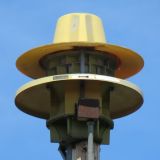
Banshee 115 (1973-2004)
The Banshee 115 (Not to be confused with the SuperBanshee, whose original model name was the Banshee 115) was introduced sometime in the 1970s, replacing the Banshee 110. The Banshee 115 received an updated design, with a fiberglass cover now protecting the motor and its wiring, giving the Banshee 115 its distinctive "fedora" look. The motor's horsepower was upgraded to 15 hp, which allowed the siren to reach 117 dB at 100 ft for single-tone models, and 112 dB for dual-tone models. Because of this, it ran exclusively on three-phase power.
The 8/12 option would be dropped, leaving the Banshee 115 to be available in only 8-port single tone and 9/12 port dual tone. Like the Banshee 110, the Banshee 115 was available as a three-signal model with a damper in the form of the Banshee 115-C, allowing it to do a pulse signal. The Banshee 115 would be sold until 1994 when ACA went bankrupt and reformed into ASC. The Banshee 115 would then be sold as the OM-117, which was 8-port single tone as standard, with 9/12 port dual tone being optional. The OM-117 would be sold until 2004, when it, alongside nearly every other ACA-era siren, was replaced by the Tempest series of sirens.
After the OM-117 was discontinued in 2004, the patent for the OM-117, along with the RM-127, would be sold to an Ohio-based company named Werden Electric, which produced their variant of the Banshee, named the B-115. The B-115 is nearly identical in appearance and performance to an OM-117, with the only major difference being the motor cover, which is no longer shaped like a fedora. Like the P-127 that Werden produced, the B-115 only came in an 8-port single tone. Only one unit currently exists, in Casstown, OH.
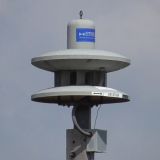
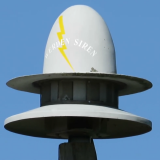
Performance Plus Banshee/OM-120 (1989-2004)
In 1989, ACA experimented with a DC battery backup variant of the Banshee 115, known as the "Performance Plus" Banshees, and was sold alongside the Performance Plus Penetrators to compete with Federal's 2001-SRN and the various electronic sirens available at the time such as the Federal Signal EOWS and Whelen WPS-2700 and 2800 that boasted DC power with battery backup and were proving to be very popular. After ACA became ASC in 1994, the siren was renamed to the OM-120.
Unlike most DC sirens produced today, these used a DC-to-AC converter to convert the DC power from the batteries to the three-phase AC power the motor used. This was rather inefficient due to the increased load on the batteries, but ACA chose not to invest in a DC motor for unknown reasons despite the technology being available as proven by Federal's 2001-SRN. These had a slightly different shroud design compared to the Banshee 115, lacking the distinctive fedora-shaped motor cover and leaving the motor bare like the Banshee 110. A rounded surface was added under the top skirt, which would function similarly to the cells of a Modulator, Whelen WPS-2900 or ASC i-FORCE, projecting the sound more outwards instead of downwards, increasing the siren's range. The bottom skirt remained unchanged.
The OM-120 came exclusively in a 9-port single tone, similar to the PN-20, and was driven by a 7.5 hp AC motor running off of converted DC power. The design improvements and higher pitch allowed the siren to reach 120 dB at 100 ft. The OM-120 was mildly successful, although most cities opted for other sirens. With the introduction of the Tempest series of sirens in 1998, the OM-120 became obsolete. The OM-120 would be discontinued in 2004, alongside the OM-117.
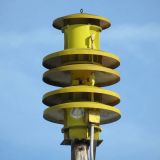
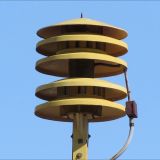
SuperBanshee (1968-1994)
Originally released in 1968 as the Banshee 115 in ACA's early catalog, the name was changed to the Banshee 120 after the regular Banshee 115 was released in 1973 and is also commonly referred to as the SuperBanshee. The SuperBanshee is a vertical dual-rotor variant of the Banshee, which was intended to compete with Federal Signal's XT22 sirens. The SuperBanshee comes exclusively in 8/12 port dual tone, with the top rotor being 12 ports and the bottom rotor being 8 ports. The siren is driven by a 20 hp three-phase motor, and the siren was rated for 120 dB at 100 ft, the loudest of the AC-powered Banshees.
Like the regular Banshee, the SuperBanshee uses fiberglass skirts to project the sound, one above and below each rotor, and these could come with or without lips on the skirts. The SuperBanshee was available in both two-signal and three-signal models, with the three-signal variants having extended intakes with butterfly valve dampers inside each intake which allow the siren to perform hi-lo and pulse signals. Like most sirens with dampers, these are prone to failure or freezing if they are not regularly maintained or used. Only one example of a three-signal SuperBanshee with functioning dampers exists in active service, a unit located in Johnson Creek, WI.
The SuperBanshee was extremely similar to the Soundmaster sirens produced by Soundmaster Signals, Inc., who used a very similar design of the rotor/stators for their Soundmaster 115 and 125. ACA considered suing Soundmaster for this, although it appears to have been settled out of court. The SuperBanshee itself was never a popular siren, being outsold by the single-rotor Banshees, as it was outperformed by the Cyclone which was also smaller and easier to install. Despite its lack of popularity, its production lasted until ACA's closure in 1994. The motor from this siren would later be used for the prototypical Penetrator-25, though these never made it to production. A few two and three-signal units remain in service today, although fewer survive today than even the Soundmaster 115 that it inspired.